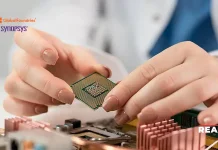In today’s fast-paced tech world, making computer chips is tough. Old machines slow things down, making it hard to keep up with demand for faster, better gadgets. This is where semiconductor manufacturing equipment pitches in. It’s like a high-tech toolbox for making computer chips. With fancy tools like super-precise printers and special machines for handling tiny wafers, it helps chip-makers work faster and smarter. According to Extrapolate, the global semiconductor manufacturing equipment market is projected to reach a valuation of $134.58 billion by 2030. By making production smoother and helping create better chips, this billion-dollar equipment is like a superhero for the tech industry, making cool gadgets possible.
What is Semiconductor Manufacturing Equipment?
Semiconductor manufacturing equipment refers to the specialized machinery and tools used in the production process of semiconductor devices, such as integrated circuits and memory chips. These machines are essential for various stages of semiconductor fabrication, including lithography, etching, deposition, and inspection. They play a critical role in ensuring the precise and efficient manufacturing of semiconductor components that power modern electronics and technological innovations.
What are the Applications of Semiconductor Manufacturing Equipment?
These equipments are instrumental in the production of semiconductors, playing a pivotal role in crafting various semiconductor components like transistors, diodes, CPUs, and memory units. These components are indispensable for regulating electricity flow, conducting arithmetic operations, and storing data in electronic devices. Furthermore, this equipment is also utilized in crafting CMOS image sensors crucial for capturing high-resolution images and videos, thus driving advancements in camera technology.
The precision and efficiency provided by these tools are essential for ensuring the reliability and performance of semiconductors. Leveraging advanced machining techniques such as precision cutting, polishing, and etching, manufacturers create intricate patterns and structures on semiconductor materials, enabling them to achieve desired electrical properties and functionality.
Why is the World Embracing Semiconductor Manufacturing Equipment?
Semiconductor manufacturing equipment is becoming increasingly indispensable across various sectors, from the booming electric vehicle industry to transformative technologies like the Internet of Things (IoT).
The surge in electric, connected, and autonomous vehicles relies heavily on semiconductors, propelling the demand for equipment used in semiconductor fabrication. For instance, while traditional automobiles typically incorporate around $330 worth of semiconductors, hybrid electric vehicles can feature significantly more, ranging from $1,000 to $3,500. This shift underscores the burgeoning market for semiconductor manufacturing equipment.
Moreover, according to CRS Reports, the average number of semiconductor chips in a car stands at approximately 3,000, with hybrid electric vehicles potentially surpassing this figure, indicating sustained growth in semiconductor demand within the automotive sector.
Additionally, the rapid advancement of artificial intelligence (AI) has spurred the demand for semiconductors, particularly in the realm of deep learning chips—a critical component of AI systems. As per the United States International Trade Commission, the artificial intelligence semiconductor market was valued at over $17 billion in 2017 and is projected to reach $65 billion by 2025. This escalating trend in the semiconductor industry is further fueling the expansion of the market.
Principles of Semiconductor Manufacturing Equipment Components
Let’s simplify the steps involved in semiconductor manufacturing:
- Circuit Design and Pattern Design: This step is like creating a recipe for cooking. Engineers use special computer programs to design precise instructions for circuits to perform specific tasks. It’s like designing intricate patterns needed for semiconductor devices.
- Photomask Creation: Imagine making a stencil for drawing. In semiconductor manufacturing, this involves creating a special plate called a photomask. This plate helps transfer detailed circuit patterns onto a tiny silicon wafer, guiding the creation of tiny features on the wafer’s surface.
- Front-End Process: Here, the actual making of semiconductor chips takes place. It’s similar to building a miniature city on a silicon wafer. The process includes cleaning the wafer, adding layers of materials, and using techniques like etching and implantation to form the structures needed for the semiconductor components.
- Back-End Process: This step involves turning the silicon wafer with its chip structures into individual pieces, similar to slicing a cake. The back-end process includes separating the wafer into individual chips and then subjecting them to various steps. It’s like adding final touches to each chip, ensuring they are properly packaged and thoroughly tested for quality.
Final Takeaway
The production of semiconductor devices relies heavily on specialized tools and equipment, which are indispensable to the semiconductor manufacturing sector. Companies like Applied Materials have emerged as major suppliers of the machinery essential for semiconductor production, keeping pace with the industry’s evolution. Moreover, various countries are actively investing in establishing facilities to bolster the overall growth of the market.
For example, China has set ambitious goals to develop its own domestic semiconductor industry, aiming to reduce dependence on foreign semiconductor imports. This initiative involves substantial investments in both creating and acquiring semiconductor technologies. Given the critical importance of semiconductor manufacturing equipment to the sector, both businesses and governments must prioritize efforts in this area to ensure sustained growth and innovation.
Browse More Posts:-
Global Connected TV Market Future Trends, Revenue Growth & Leading Players, Forecast By Year 2031
Global Connected TV Market Future Trends, Revenue Growth & Leading Players, Forecast By Year 2031
Global Connected TV Market Future Trends, Revenue Growth & Leading Players, Forecast By Year 2031




